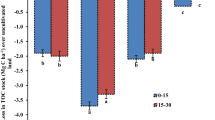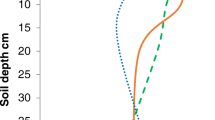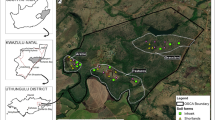Abstract
Soil organic matter content in water-stable aggregates (WSA) in the arid ecosystems (abandoned agricultural lands especially) of China is poorly understood. In this study, we examined the WSA sizes and stability, and soil organic carbon (OC) and nitrogen (N) contents in agricultural lands with abandonment ages of 0, 3, 12, 20, 30 and 40 years, respectively, in the Minqin Oasis of Northwest China. The total soil OC and N contents at depths of 0–20, 20–40 and 40–60 cm in abandoned agricultural lands were compared to those in cultivated land (the control). Agricultural land abandonment significantly (P<0.05) influenced the distribution of MWD (mean weight diameter), and OC and N contents. There were significant increases in MWD and the proportion of macroaggregates (sizes >0.25 mm) as the age of agricultural land abandonment increased. The effect of abandonment ages of agricultural lands on MWD was determined by the changes of OC and N accumulation in WSA sizes >2 mm. The total OC and N contents presented a stratification phenomenon across soil depths in this arid ecosystem. That is, both of them decreased significantly at depths of 0–20 and 40–60 cm while increased at the depth of 20–40 cm. The WSA sizes <0.053 mm had the highest soil OC and N contents (accounting for 51.41%–55.59% and 42.61%–48.94% of their total, respectively). Soil OC and N contents in microaggregates (sizes 0.053–0.25 mm) were the dominant factors that influenced the variations of total OC and N contents in abandoned agricultural lands. The results of this study suggested that agricultural land abandonment may result in the recovery of WSA stability and the shifting of soil organic matter from the silt+clay (<0.053 mm) and microaggregate fractions to the macroaggregate fractions. However, agricultural land abandonment did not increase total soil OC and N contents in the short-term.
Similar content being viewed by others
References
Ahn M Y, Zimmerman A R, Comerford N B, et al. 2009. Carbon mineralization and labile organic carbon pools in the sandy soils of a north Florida Watershed. Ecosystems, 12(4): 672–685.
Ashagrie Y, Zech W, Guggenberger G, et al. 2007. Soil aggregation, and total and particulate organic matter following conversion of native forests to continuous cultivation in Ethiopia. Soil and Tillage Research, 94(1): 101–108.
Ayoubi S, Karchegani P M, Mosaddeghi M R, et al. 2012. Soil aggregation and organic carbon as affected by topography and land use change in western Iran. Soil and Tillage Research, 121: 18–26.
Barral M T, Arias M, Guérif J. 1998. Effects of iron and organic matter on the porosity and structural stability of soil aggregates. Soil and Tillage Research, 46(3–4): 261–272.
Bonifacio E, Santoni S, Falsone G, et al. 2006. Wet aggregate stability of some Botswana soil profiles. Arid Land Research and Management, 20(1): 15–28.
Bremner J M. 1996. Nitrogen-total. In: Sparks D L. Methods of Soil Analysis. Part 3. Chemical Methods. Madison, WI: Soil Science Society of America, 1085–1121.
Carter M R. 1996. Characterization of soil physical properties and organic matter under long-term primary tillage in a humid climate. Soil and Tillage Research, 38(3–4): 251–263.
Celik I. 2005. Land-use effects on organic matter and physical properties of soil in a southern Mediterranean highland of Turkey. Soil and Tillage Research, 83(2): 270–277.
Chrenková K, Mataix-Solera J, Dlapa P, et al. 2014. Long-term changes in soil aggregation comparing forest and agricultural land use in different Mediterranean soil types. Geoderma, 235–236: 290–299.
Cramer V A, Hobbs R J, Standish R J. 2008. What’s new about old fields? Land abandonment and ecosystem assembly. Trends in Ecology and Evolution, 23(2): 104–112.
Deng L, Shangguan Z P, Sweeney S. 2013. Changes in soil carbon and nitrogen following land abandonment of farmland on the Loess Plateau, China. PLoS ONE, 8(8): e71923, doi: 10.1371/journal.pone.0071923.
DuPont S T, Culman S W, Ferris H, et al. 2010. No-tillage conversion of harvested perennial grassland to annual cropland reduces root biomass, decreases active carbon stocks, and impacts soil biota. Agriculture, Ecosystems and Environment, 137(1–2): 25–32.
Gabarrón-Galeote M A, Trigalet S, van Wesemael B. 2015. Soil organic carbon evolution after land abandonment along a precipitation gradient in southern Spain. Agriculture, Ecosystems and Environment, 199: 114–123.
Grüeneberg E, Schöening I, Hessenmöller D, et al. 2013. Organic layer and clay content control soil organic carbon stocks in density fractions of differently managed German beech forests. Forest Ecology and Management, 303: 1–10.
Haynes R J. 2000. Labile organic matter as an indicator of organic matter quality in arable and pastoral soils in New Zealand. Soil Biology and Biochemistry, 32(2): 211–219.
Huang L, Wang C Y, Tan W F, et al. 2010. Distribution of organic matter in aggregates of eroded Ultisols, Central China. Soil and Tillage Research, 108(1–2): 59–67.
Institute of Soil Science, Chinese Academy of Sciences. 1978. Soils in China. Beijing: Science Press. (in Chinese)
Jastrow J D. 1996. Soil aggregate formation and the accrual of particulate and mineral-associated organic matter. Soil Biology and Biochemistry, 28(4–5): 665–676.
Jin X B, Wang S M, Zhou Y K. 2008. Dynamic of organic matter in the heavy fraction after abandonment of cultivated wetlands. Biology and Fertility of Soils, 44(7): 997–1001.
John B, Yamashita T, Ludwig B, et al. 2005. Storage of organic carbon in aggregate and density fractions of silty soils under different types of land use. Geoderma, 128(1–2): 63–79.
Knops J M H, Tilman D. 2000. Dynamics of soil nitrogen and carbon accumulation for 61 years after agricultural abandonment. Ecology, 81(1): 88–98.
Kosmas C, Danalatos N G, Gerontidis St. 2000. The effect of land parameters on vegetation performance and degree of erosion under Mediterranean conditions. Catena, 40(1): 3–17.
Kurganova I, Lopes de Gerenyu V, Six J, et al. 2014. Carbon cost of collective farming collapse in Russia. Global Change Biology, 20(3): 938–947.
Li X G, Li F M, Rengel Z, et al. 2006. Cultivation effects on temporal changes of organic carbon and aggregate stability in desert soils of Hexi Corridor region in China. Soil and Tillage Research, 91(1–2): 22–29.
Linsler D, Geisseler D, Loges R, et al. 2013. Temporal dynamics of soil organic matter composition and aggregate distribution in permanent grassland after a single tillage event in a temperate climate. Soil and Tillage Research, 126: 90–99.
Lützow M V, Kögel-Knabner I, Ekschmitt K, et al. 2006. Stabilization of organic matter in temperate soils: mechanisms and their relevance under different soil conditions: a review. European Journal of Soil Science, 57(4): 426–445.
Manna M C, Swarup A, Wanjari R, et al. 2007. Long-term fertilization, manure and liming effects on soil organic matter and crop yields. Soil and Tillage Research, 94(2): 397–409.
Miwa A, Yukio M, Hiroshi T, et al. 2014. Changes in water stable aggregate and soil carbon accumulation in a no-tillage with weed mulch management site after conversion from conventional management practices. Geoderma, 221–222: 50–60.
Nelson D W, Sommers L E. 1996. Total carbon, organic carbon, and organic matter. In: Sparks D L, Page A L, Helmke P A, et al. Methods of Soil Analysis. Part 3. Chemical Methods. Madison, WI: Soil Science Society of America, 961–1010.
Novara A, La Mantia T, Rühl J, et al. 2014. Dynamics of soil organic carbon pools after agricultural abandonment. Geoderma, 235–236: 191–198.
Onweremadu E U, Onyia V N, Anikwe M A N. 2007. Carbon and nitrogen distribution in water-stable aggregates under two tillage techniques in Fluvisols of Owerri area, southeastern Nigeria. Soil and Tillage Research, 97(2): 195–206.
Prishchepov A V, Radeloff V C, Baumann M, et al. 2012. Effects of institutional changes on land use: agricultural land abandonment during the transition from state-command to market-driven economies in post-Soviet Eastern Europe. Environmental Research Letters, 7(2): 024021, doi:10.1088/1748-9326/7/2/024021.
Puget P, Chenu C, Balesdent J. 2000. Dynamics of soil organic matter associated with particle-size fractions of water-stable aggregates. European Journal of Soil Science, 51(4): 595–605.
Raiesi F. 2012. Soil properties and C dynamics in abandoned and cultivated farmlands in a semi-arid ecosystem. Plant and Soil, 351(1–2): 161–175.
Shang Z H, Cao J J, Guo R Y, et al. 2014. The response of soil organic carbon and nitrogen 10 years after returning cultivated alpine steppe to grassland by abandonment or reseeding. Catena, 119: 28–35.
Six J, Elliott E T, Paustian K, et al. 1998. Aggregation and soil organic matter accumulation in cultivated and native grassland soils. Soil Science Society of America Journal, 62(5): 1367–1377.
Six J, Paustian K, Elliott E T, et al. 2000a. Soil structure and organic matter: I. Distribution of aggregate-size classes and aggregate-associated carbon. Soil Science Society of America Journal, 64(2): 681–689.
Six J, Elliott E T, Paustian K. 2000b. Soil structure and organic matter: II. A normalized stability index and the effect of mineralogy. Soil Science Society of America Journal, 64(3): 1042–1049.
Six J, Paustian K. 2014. Aggregate-associated soil organic matter as an ecosystem property and a measurement tool. Soil Biology and Biochemistry, 68: A4–A9.
Spohn M, Giani L. 2011. Impacts of land use change on soil aggregation and aggregate stabilizing compounds as dependent on time. Soil Biology and Biochemistry, 43(5): 1081–1088.
Sui Y Y, Jiao X G, Liu X B, et al. 2012. Water-stable aggregates and their organic carbon distribution after five years of chemical fertilizer and manure treatments on eroded farmland of Chinese Mollisols. Canadian Journal of Soil Science, 92(3): 551–557.
Sun D F, Dawson R, Li B G. 2006. Agricultural causes of desertification risk in Minqin, China. Journal of Environmental Management, 79(4): 348–356.
Tisdall J M, Oades J M. 1982. Organic matter and water-stable aggregates in soils. European Journal of Soil Science, 33(2): 141–163.
Waters A G, Oades J M. 1991. Organic matter in water-stable aggregates. In: Wilson W S. Advances in Soil Organic Matter Research: The Impact on Agriculture and the Environment. Cambridge: The Royal Society of Chemistry, 163–174.
Whalen J K, Chang C. 2002. Macroaggregate characteristics in cultivated soils after 25 annual manure applications. Soil Science Society of America Journal, 66(5): 1637–1647.
Wiesmeier M, Steffens M, Mueller C W, et al. 2012. Aggregate stability and physical protection of soil organic carbon in semi-arid steppe soils. European Journal of Soil Science, 63(1): 22–31.
Yamashita T, Flessa H, John B, et al. 2006. Organic matter in density fractions of water-stable aggregates in silty soils: Effect of land use. Soil Biology and Biochemistry, 38(11): 3222–3234.
Yang H, Li X B. 2000. Cultivated land and food supply in China. Land Use Policy, 17(2): 73–88.
Zagal E, Córdova C, Sohi S P, et al. 2013. Free and intra-aggregate organic matter as indicators of soil quality change in volcanic soils under contrasting crop rotations. Soil Use and Management, 29(4): 531–539.
Zhang Y, Li X B, Song W. 2014. Determinants of cropland abandonment at the parcel, household and village levels in mountain areas of China: A multi-level analysis. Land Use Policy, 41: 186–192.
Zhu B B, Li Z B, Li P, et al. 2010. Soil erodibility, microbial biomass, and physical-chemical property changes during long-term natural vegetation restoration: a case study in the Loess Plateau, China. Ecological Research, 25(3): 531–541.
Author information
Authors and Affiliations
Corresponding author
Rights and permissions
About this article
Cite this article
Wang, J., Liu, L., Qiu, X. et al. Contents of soil organic carbon and nitrogen in water-stable aggregates in abandoned agricultural lands in an arid ecosystem of Northwest China. J. Arid Land 8, 350–363 (2016). https://doi.org/10.1007/s40333-016-0042-7
Received:
Revised:
Accepted:
Published:
Issue Date:
DOI: https://doi.org/10.1007/s40333-016-0042-7




